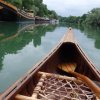I'm nearing the end of a Strickland restoration and was thinking I'd be kneeling or perhaps sitting with a second paddler, when I found two bits like this at the bottom of the box and realised there must have been a seat once.
I found some oak, 20mm square, which seems strong enough. The wider piece is 18", the narrower 15", the two fore and aft pieces 9", the same as the cutout. The actual seat will be 12" wide and I'll use 5mm leather thong at 1" spacing, 6mm drill through the oak, fore and aft one piece and side to side one piece, knotted at each end so I can tighten when necessary.
Does that seem adequate or too much?
Thanks, Charlie.

I found some oak, 20mm square, which seems strong enough. The wider piece is 18", the narrower 15", the two fore and aft pieces 9", the same as the cutout. The actual seat will be 12" wide and I'll use 5mm leather thong at 1" spacing, 6mm drill through the oak, fore and aft one piece and side to side one piece, knotted at each end so I can tighten when necessary.
Does that seem adequate or too much?
Thanks, Charlie.


